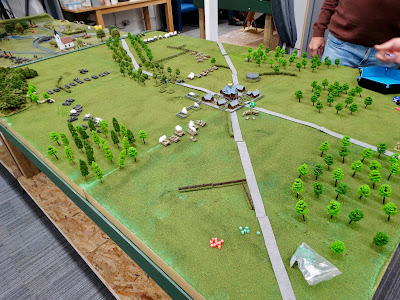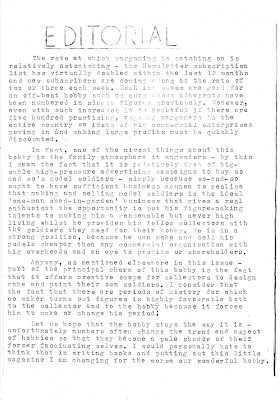There is considerable potential for complication in Ancient wargaming, resulting from the long time period to be covered, and the resulting plethora of troop types and combat styles. It takes a bit of talent to boil all these down into a workable game, but Philip Garton appears to have achieved this in his 160 page, softback rulebook, Three Ages of Rome, published by Helion.

KEITH'S WARGAMING BLOG. This blog has been created to share my exploits in the hobby of wargaming. I game in the WW2, Seven Years War, Napoleonic and Ancient periods. The blog also contains a few details of my book 'Airborne Armour'. Please don't quit the site without leaving a comment, even if not related to a specific post. Most wargamers have something interesting to say about the hobby!
Sunday, 3 November 2024
Three Ages of Rome and The Battle of Piranthus
Friday, 25 October 2024
Cotswold Wargaming Day 2024 - Another Success!
I had a good feeling about the new venue for the CWD, and it turned out I was right. Andy and Derek at Big Battles Ltd in Cirencester had set out the variety of tables needed in advance, and I was able to pop in to check things out and put names on tables the preceding Friday. I left convinced that everything was going to be fine.
I was a little concerned about numbers, as a few gamers had to cancel quite close to the date for a variety of completely understandable reasons. But in the end, the show was buzzing - Andy said he counted 40 people at one point, which would be a record. The venue cost £300 to hire, and I collected £310 from attendees at a tenner each, so I was well content. The extra tenner will go to the 'Many Tears' dog rescue charity, who do wonderful work rescuing mistreated and homeless dogs.
 |
| Overview of the hall. There were 8 games on show. |
 |
| My own game, Poland 1939 using my own Startline rules. A quickly-conceived bit of fun involving an encounter game between elements of 10th Mechanised Brigade and 2nd Panzer Division. |
 |
| German forces close in on the Poles around the chapel. |
 |
| Next to me in 'WW2 Corner' were Matt and Paul with their 1/200th Russian Front game, using BKC II. |
 |
| Nice close-up of advancing German armour. (Courtesy Big Battles) |
 |
| Stuart Surridge and the Wyre Forest Gamers put on an impressive Ancients game which was much admired. |
 |
| All 28mm figures, each individually based. Crikey! (Courtesy Big Battles) |
 |
| Steve Johnson (centre) brought another great 'imaginations' game set in the Horse and Musket period. He came on his own, but quickly found some eager participants to help him out. |
 |
| Among whom was Dave Pike, an old wargaming buddy I hadn't seen in years. Great to catch up Dave! |
 |
| Close up of the action on Steve's table. (Courtesy Big Battles) |
 |
| Dave Kenyon and friends are another group of regulars. They brought a Franco-Prussian war game with figures sculpted and cast by Dave himself. Very impressive, and classic old-school. |
 |
| I'm afraid my attempt at a close-up of some Prussian guns doesn't do the figures justice. |
 |
| Tim Cull brought along a game based on the 1664 Battle of St Gottard, between Ottoman and Imperial forces. A typically original choice! (Courtesy Big Battles) |
 |
| The game was played through twice. (Courtesy Big Battles) |
 |
| The Cirencester Wargames Club brought along a large number of lovely Renaissance figures to fight out an imaginary battle using their own 'Risky Renaissance' rules. (Courtesy Big Battles) |
 |
| As with Tim's game they managed to play through the battle twice. In both cases, this was enabled by home-brewed, simple rules. (Courtesy Big Battles) |
 |
| Last, but definitely not least, we come to the Ian and Paul's game, which was an impressive Wild West skirmish set up. (Courtesy Big Battles) |
 |
| Finally, a nice extra facility this year was the 'chill-out area', where fatigued gamers could take a break from the rigours of combat. |
Andy and Derek very kindly agreed to judge and present the Stuart Asquith Trophy. They had no doubt that Ian and Paul's Wild West set-up was the winner, due to the magnificent and dedicated modelling skills shown in the creation of the buildings and terrain, along with the variety of fun scenarios which were played out. Chris also wished to give his own prize to the same game, and so for the second year running a single game received two prizes. I judged the Pendraken prize myself, and awarded it to Dave Kenyon's game as I fell in love with his shiny toy soldiers, and much admired his skill in both sculpting and casting them himself.
 |
| Ian and Paul with their well-earned trophy. According to Ian, the credit was all due to Paul! |
 |
| Dave receives the Pendraken Prize for 'Keith's Favourite Game'. (Courstesy Steve Johnson) |
Sunday, 29 September 2024
Donald Featherstone & Wargamer's Newsletter
The Don gets mentioned in quite a lot of my blog posts - his was the major influence during my formative years as a wargamer in the late 1960s and early 70s. I also have a bit of a soft spot for old wargaming magazines, so I was very pleased recently to be steered towards a site which has pdf versions of most of the editions of Wargamer's Newsletter, the legendary gaming fanzine produced by Mr Featherstone from 1962 to 1980.
 |
| Believed to be from the April 1964 edition, one of those missing from the online collection. |
If you're up for a bit of nostalgia, I'd highly recommend visiting the site. Truth be told, apart from nostalgia, the magazines themselves often have little to offer the contemporary gamer. What I'm usually looking for are scenarios, but they are surprisingly few and far between. This is an area where modern magazines score quite highly over the older publications. But there is always the possibility of finding something really interesting. For example, the January 1966 edition features some Napoleonic wargames rules by a certain Philip Barker - which extend to a magnificent two and a bit typewritten pages. What is clear is that the magazine was a genuine attempt to bring gamers together and give them a voice, in a pre-internet world.
Talking of interesting snippets, I found the following editorial in the August 1964 edition, the oldest in the collection. Rather than quote from it, I'll give you the whole thing. What interested me is the relevance to a post of mine from August regarding the professionalisation and commercialisation of the hobby, and the possible conflict of this process with the hobby's amateur roots. I won't labour the point, but the subject was obviously concerning Donald Featherstone all of sixty years ago.
 |
| Click to expand and read more easily. |
So, if you have half an hour to fill, dipping in to this resource is certainly worth it. For gamers of my age it's pure nostalgia, and for younger gamers it's a pretty good insight into our hobby in its early years.
Wednesday, 7 August 2024
Airborne Armour - New Edition
I was pleasantly surprised recently when Helion & Company got in touch with me to say a new edition of Airborne Armour was coming out, and they would be sending me a free author copy.
Friday, 2 August 2024
Amateur or Professional? A response to Richard Clarke
Wargames, Soldiers & Strategy magazine issues 130 and 131 have both been corkers. Every now and then I get to thinking that wargames magazines have had their day, then I get proved wrong, usually by WSS. In both issues there were interesting articles, some useful scenarios, and interesting review sections. Oh yes, and some decent maps as well.
I know some of you find the 'think piece' articles, where issues around the way the hobby is developing are aired, a bit uninteresting - too much navel-gazing when we should be thinking about painting figures and playing games. For myself, I find them worthwhile. I spend a lot of my average day thinking about and planning my wargaming, plus the time I actually spend gaming, and I like to try and understand what I'm doing and why.
To cut to the chase, WSS130 contained an article by Richard Clarke (of the Too Fat Lardies, of course) called 'Naked Communication'. As you'd expect, it was well worth reading, and largely contained a lot of common sense. Broadly, it was about the kickback some of the bigger commercial wargaming companies occasionally get when they introduce new rules, new supplements and new figures for reasons that seem to have more to do with increasing revenue than looking after their customers. Of course, if you run and/or own a company, increasing revenue is your job. The problem is that miniature wargaming is largely an amateur undertaking, and ordinary wargamers can react adversely to what they see as commercialism.
This is the crux of Richard's article, and it was a couple of his statements concerning the amateur/professional relationship that made me want to write a response. Let's start with the first quote that made me think I disagreed with him.
"...pleased as we must be that the hobby is more accessible and that products are more available, we somehow retain an odd attachment to the amateur roots of the hobby."
'An odd attachment to the amateur roots of the hobby'. What's odd about being attached to the hobby's roots? Let's check out the definition of hobby:
Tuesday, 23 July 2024
"Testing, Testing..."
In early May, just before my wife and I set off for our 8 week Scandinavian adventure in our motorhome, I was working on two ideas that I thought might enhance Startline. The first was a new, alternate move sequence (rather than the current IGO-UGO), and a new morale system. Both offered interesting and quite fundamental changes to the game, so on my return I was keen to try them out.
 |
| Packing up the motorhome can be time consuming. |
 |
| Set-up. Germans attacking from left. Half the Polish force started off-table in reserve. |
 |
| German armoured cars and motorcyle infantry making good progress... |
 |
| ...until the Vickers tanks arrive and things get messy. |
 |
| The German heavy armoured cars managed to penetrate into the rear of the village. You can see that their Morale Value is 8. |
 |
| Set-up. Germans to the left once more. |
 |
| Half-way point. Tanks casualties high on both sides. |
 |
| Polish infantry retreating from the crossroads area. |
Friday, 28 June 2024
The Stockholm Rendezvous
No, I've not started writing spy thrillers. My wife and I have been on holiday in Scandinavia since early May, and just recently we were having a couple of days in Stockholm when I lost my phone. Some nice person handed it in at the Nobel Prize Museum (as it was found nearby).
 |
| Ah, Mr Bond, I've been expecting you... |
 |
| The Front Museum, near Hanko, Finland. I'd forgotten what a big gun the Pak40 is. Manhandling this beast must have been a real bugger. |
 |
| As a comparison, the Russian 45mm anti-tank gun seems much more manageable. |
 |
| Outside the museum is another 45mm, mounted in a replica bunker. |
 |
| The enemy's view of the same weapon. Properly camouflaged, this position would have been hard to identify. |
 |
| Captured Soviet T-26 at the same museum. |



















